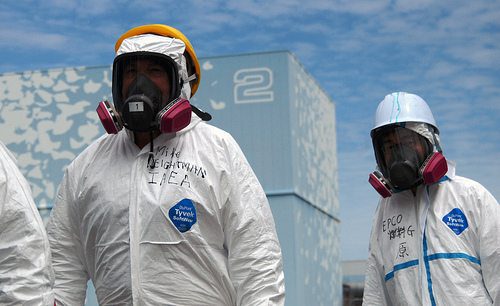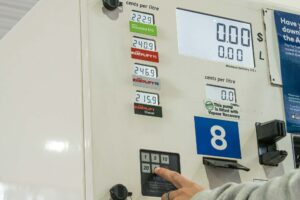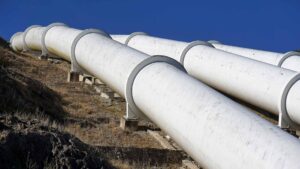It is a year since the Fukushima reactor was swamped by a tsunami, knocking out the cooling systems and causing a series of explosions. A large area is still off-limits to the local people, with about 100,000 residents unable to return home.
Taking responsibility for Australian uranium
We now know that Australian uranium fuelled the Fukushima reactors, so we have some responsibility for the accident and its consequences. It is a reminder that we should have a serious public debate about the mining and export of uranium, rather than simply seeing it as an export earner like gold or diamonds.
The bipartisan agreement in Canberra to allow export of uranium to India, suspending our traditional insistence that importing countries being signatories of the Nuclear Non-Proliferation Treaty, is a real worry.
As Robert Milliken wrote 30 years ago in the National Times, whenever our safeguards get in the way of a commercial deal, the safeguards get watered down.
Still a risky business
Before Fukushima, there had been a surge of enthusiasm here for nuclear power. The problems in Japan have probably ended the risk of Australia going down the nuclear path for the foreseeable future.
Fukushima is also a reminder that financial considerations can lead to dangerous short cuts in design and operation. We have known since Three Mile Island in 1979 that a build-up of hydrogen gas can be risky, but the simple preventive measures were not installed in the Japanese reactors. It is obviously advisable to have fail-safe cooling systems, but these reactors were destroyed when the tsunami swamped the electricity supply.
While enthusiasts claim new reactors would not have the technical limitations of Chernobyl or be sited as dangerously as Fukushima, there will always be some risk of accidents. I was recently back in Christchurch and saw the ruins of the city centre, including the coffee shop where I had been waiting for my lunch on 22 February 2011 when the earthquake struck. Given the devastation caused by that event, I am glad New Zealand does not have nuclear reactors.
If we wanted to build power reactors in Australia, the need for cooling water would demand a coastal location, where there will always be a risk of storm surges or tsunamis.
We simply don’t know enough about the Earth to be totally confident that any specific location is safe. An accident in a nuclear power station is a much more serious risk than a problem with any form of renewable energy supply.
Nuclear doesn’t appeal to governments
When I was a young physicist, it seemed that nuclear power would be cheap, clean and safe. I went to the UK and accepted support from their Atomic Energy Authority for research on a problem affecting the useful life of fuel elements in power reactors.
But nuclear power has remained expensive, needing public subsidies wherever it operates. With insurance companies unwilling to back nuclear energy, taxpayers foot the bill when things go wrong.
The peak of installed nuclear power happened last century. Despite some claims, there hasn’t been a renaissance of nuclear energy, only a resurgence of pro-nuclear talk. In the years 2008 and 2009, the world retired 3000 Megawatts of old nuclear capacity and only 1000 MW was brought on line. In the same two years, about 60,000 MW of new wind power was commissioned.
As with other products that are unacceptable in advanced countries, the nuclear industry is now concentrating its efforts in the developing world.
There are better low-emission options
The only reason anyone would consider nuclear power in Australia is because climate change is a serious threat. If nuclear power were the only effective way of slowing climate change, we would have to think about it. But we don’t face that terrible dilemma. There are much better ways of slowing climate change.
Nuclear is certainly not a timely response to climate change. The pro-nuclear Switkowski committee concluded it would take 10 to 15 years to build one nuclear reactor. Their hypothetical crash program of 25 reactors by 2050 would only slow the growth in our release of greenhouse gases, not achieve the needed reduction.
It is too expensive. Again, Switkowski’s group conceded there would need to be both a carbon price and other government subsidies to make nuclear look competitive.
The problem of waste remains unsolved. Accidents are not the only risk to society from nuclear power. Nobody has yet demonstrated safe permanent management of radioactive waste, more than 55 years after the nuclear experiment began.
There are better alternatives. A Commonwealth report 20 years ago found that we could get all our electricity from a mix of renewables by 2030. A study released last year concluded that we could achieve that goal by 2020 if we were serious about it. That would be a responsible approach to slow down global warming.
The clean energy response is quicker, less expensive and less dangerous than nuclear reactors. There is no risk to the community from terrorists stealing wind turbine blades or earthquakes shattering solar panels.
A mix of renewable supply systems would also decentralise energy production, so it would be good for regional Australia. It would not require new regulatory systems, development of new technical skills or an unwise dependence on foreign expertise.
We know how to de-commission wind turbines and solar panels at the end of their life, at little cost and with no risk to the community.
So, why should taxpayers fund a slow and expensive energy option when alternatives are significantly cheaper and pose less risk? Finally, which elected politician would now support a reactor in their electorate?








